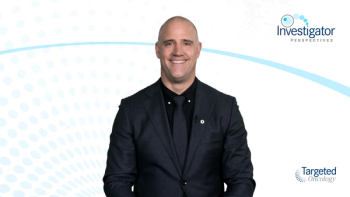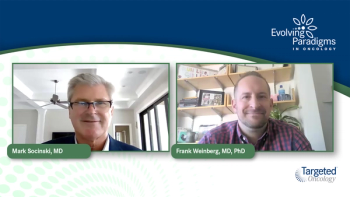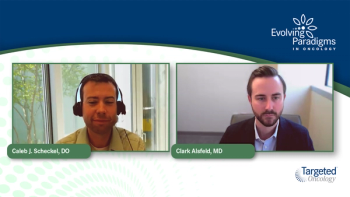
Patient Case 1: A 70-Year-Old Woman with Differentiated Thyroid Cancer
Marcia S. Brose, MD, PhD, introduces our first patient case, a 70-year-old woman with differentiated thyroid cancer (DTC).
Episodes in this series

Marcia S. Brose, MD, PhD: Hello, my name is Marcia Brose, and I’m the chief of cancer services for Jefferson Northeast Sidney Kimmel Cancer Center. I’m here today to talk to you about differentiated thyroid cancer. To start, we’re going to be talking about 2 cases. The first case is a woman who’s 70 years old and was fairly frail and presents with a painless lump on her neck. She was otherwise asymptomatic. Her past medical history was unremarkable and on physical exam, she had a palpable non-tender soft solitary right of the midline neck mass and otherwise had no other findings. The clinical workup and initial treatment included labs, which showed that she had a normal TSH [thyroid-stimulating hormone]. The ultrasound of her neck revealed a 3.4-centimeter suspicious right mass arising from the right thyroid, 4 suspicious supraclavicular lymph nodes with the largest 1, 2.2 centimeters in size. An ultrasound-guided by needle aspirate of the thyroid mass and the largest lymph node confirmed papillary thyroid carcinoma. She underwent a total thyroidectomy with central compartment and right selective neck dissection. Pathology revealed a 3.4-centimeter papillary thyroid cancer arising in the right lobe of the thyroid, which had tall cell features and extrathyroidal extension. Two of 6 positive central compartment lymph nodes were found. The largest was 1.8 centimeters and 4 of 13 right lateral compartments had revolved nodes with the largest being 2.2 centimeters in size. She also had positive extranodal extension there.
At the time of her diagnosis, she was staged as T2N1MX, and she had an ECOG [Eastern Cooperative Oncology Group] performance status of 0. Subsequently, 3 months later, she was treated with radioactive iodine with 150 millicuries. Her whole-body scan at that time showed uptake in the neck that was consistent with a thyroid remnant, but no other uptake in the lungs. She had a follow-up 6 months after that. Her TSH at that time was 0.2 and her thyroglobulin was 28 nanograms per milliliter. She had no antithyroglobulin antibodies. A chest CT at that time showed 8 small bilateral lung nodules with the largest 1 of 1.3 centimeters. A follow-up CT of her neck and chest 3 months after that was notable for 1 to 2 millimeters growth of several lung nodules and 3 new distinct 9.5-millimeter lung nodules. She had next-generation sequencing, which was negative for mutations and rearrangements. And she was started on Lenvatinib [Lenvima] at a dose of 24 milligrams PO [by mouth] daily; once daily.
Let’s think a bit about our initial impressions of this case. When I think about the treatment approach for this patient, in general, I would say I’m pretty much in agreement with the way this patient was presented and treated. The one caveat I will say is in a patient such as this, she’s obviously at a very high risk for metastatic disease. What is missing, and I think is a historic problem, is that she had no CAT scan done at the time of her radioactive iodine whole-body scan. I think now it really should be a standard of care that following the whole-body scan, we get a CT in any patient who has high-risk disease, either a large primary, multiple lymph nodes, extrathyroidal extension, or extra lymph node extension because these patients are likely to have metastatic disease. And if you only have the imaging from the thyroid uptake scan, you’re likely to miss RAI [radioactive iodine] non-avid disease. I think that I would’ve done everything the same, except that I would’ve probably gotten a CAT scan with contrast following the whole-body scan after she had received her treatment.
I think that a lot of people would say, “Well, she’s a little frail and she’s 70 years old; would you start the patient on 24 milligrams?” We’ll talk a little bit more about that when we’re in the later questions. But in general, I think I would’ve probably followed and started the patient at 24 milligrams with a couple of caveats. The prognosis for this patient, given that they had RAI refractory disease that was advanced is not great. Her age puts her in a worse prognostic category. And clearly, she has actively progressing disease with new lesions showing up in only a 3- to 6-month period after surgery. That says to me that she has definitely a worse prognosis, as the tall cell features would’ve implied. One thing I’d actually like to point out about prognostic features is all of the details that we know about prognostic markers, whether they have BRAF mutations and whether they’re tall cell and these things. Most of that prognosis centers on whether or not they will respond to radioactive iodine. I think it’s going to be interesting. I don’t think we have the data yet to say whether those same prognostic factors still hold true in the era of multikinase therapies. And the reason for that, and I’ll give you an example, in my experience, my Hurthle cell patients are more likely to not take up radioactive iodine. And historically, Hurthle cell had a worse prognosis based really on that fact. But interestingly, in the sorafenib study and DECISION and other studies since then, my Hurthle cell patients actually do quite well. In fact, they often do better than my average RAI refractory patient. It’s not completely clear whether or not in the era of having these new levels of therapy if those prognostic features will still be the same, whether they’ll be bad in both situations and therefore the prognosis is even worse, or whether it’ll turn out that maybe the treatment with multikinase inhibitors becomes a little bit of an equalizer across the different prognostic categories.
This transcript has been edited for clarity.
Case: A 70-Year-Old Woman With Differentiated Thyroid Cancer
Initial presentation
- A 70-year-old woman presents with a painless “lump on her neck.”
- PMH: unremarkable
- PE: palpable, non-tender solitary right-of-the midline neck mass; otherwise unremarkable
Clinical workup and initial treatment
- Labs: TSH WNL
- Ultrasound of the neck revealed a 3.4 cm suspicious right mass arising from the right thyroid; 4 suspicious supraclavicular lymph nodes (LNs), largest 2.2 cm in size.
- Ultrasound-guided FNAB of the thyroid mass and the largest LN confirmed papillary thyroid carcinoma.
- Patient underwent total thyroidectomy with central compartment and right selective neck dissection.
- Pathology: 3.4 cm papillary thyroid cancer arising in the right lobe of thyroid, tall-cell features; extrathyroidal extension present;
- 2 of 6 positive central compartment lymph nodes, largest 1.8 cm
- 4 of 13 right lateral compartment involved nodes largest 2.2 cm in size, positive extra nodal extension.
- StageT2N1aMX; ECOG PS 0
Subsequent treatment and follow-up - She was treated with radioactive iodine 150 millicuries
- Whole body scan showed uptake in the neck, consistent with thyroid remnant but no uptake in the lungs
- Follow-up at 3 months
- TSH 0.2 µU/mL, thyroglobulin 28 ng/mL (negative anti-thyroglobulin antibodies)
- Chest CT scan showed 8 small bilateral lung nodules largest 1.3 cm
- Follow-up CT neck and chest scan 3 months later was notable for 1-2mm growth in several lung nodules and 3 new distinct 9.5 mm lung nodules
- Next-generation sequencing was negative for mutations, rearrangements
- Lenvatinib 24mg po qd was initiated
Case 2: A 57 Year-Old Man With Differentiated Thyroid Cancer
Initial presentation
- A 57-year-old man presents with a solitary nodule on the neck and occasional shortness of breath and intermittent excessive fatigue
- PMH: unremarkable
- PE: palpable, hard and fixed solitary nodule in the anterior neck
Clinical workup and initial treatment
- Labs: TSH 10.3 µU/mL; all others WNL
- Ultrasound of the neck revealed a 2 cm mass near the isthmus of the thyroid; several suspicious lymph nodes ranging from 0.3-2.4 cm in size
- Ultrasound-guided FNAB: confirmed papillary thyroid carcinoma; with nuclear enlargement and nuclear grooves, no colloid seen
- Patient underwent total thyroidectomy with bilateral central neck dissection
- Pathology: 2.1 cm papillary thyroid cancer arising in isthmus of the thyroid, 3 of 7 positive central compartment lymph nodes, largest 1.8 cm, positive extra nodal extension
- StageT2N1MX; ECOG PS 1
Subsequent treatment and follow-up
- He was treated with radioactive iodine 150 millicuries
- Whole body scan showed uptake in the neck; indicative of thyroid remnant
- Follow-up at 3 months TSH 0.2 µU/mL, thyroglobulin 68 ng/mL
- Neck US showed no evidence of residual disease in thyroid bed, no suspicious neck nodes. Chest CT was done: 4 lung lesions that were 0.3 and 0.6 cm in size
- The physician recommended not initiating systemic therapy and putting the patient on active surveillance










































